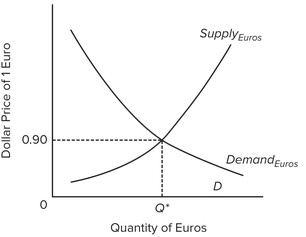Which of the following might cause an upward shift of the modern Phillips curve?
A) an increase in oil prices
B) an increase in the price of imports
C) wage agreements that include compensation for inflation
D) all of the above
E) none of the above
D
You might also like to view...
Use the following graph, which shows the market for euros, to answer the next question. Assume the United States and European governments adopt a system of flexible exchange rates. If currency traders think the European economy will experience a recession and the U.S. economy will not, this will most likely cause ________.
Assume the United States and European governments adopt a system of flexible exchange rates. If currency traders think the European economy will experience a recession and the U.S. economy will not, this will most likely cause ________.
A. the euro to depreciate B. the U.S. dollar to depreciate C. the supply of euros to decrease D. the euro to appreciate
Tammy sells woolen hats in a perfectly competitive market. The marginal cost of producing 1 hat is $24. The marginal cost of producing a second hat is $26 and the marginal cost of producing a third hat is $28. The market price of a hat is $26
To maximize profit, Tammy produces ________ per day. A) 1 hat B) 3 hats C) 2 hats D) as many hats as possible
Which of the following indicates that economies of scale have been overridden by other factors?
a. A company seeking to save on architect's fees during its move to Maryland copies the same building it used in San Francisco, so now it occupies the only office in Baltimore built to withstand earthquakes. b. The workers on the night shift at the Roadkill Diner, having no customers of their own, peel 400 potatoes, fill 300 catsup bottles, fry 100 pounds of bacon, and brew 80 quarts of coffee for the morning shift. c. Denny's Restaurant serves potatoes with its breakfasts nationwide, but in the South you can get grits instead. d. The Creepy Critters Summer Camp decides not to give campers a choice between hamburgers and hot dogs but makes creamed chipped beef on toast for everybody. e. Henry Ford said that his customers could have any color car they wanted, as long as they wanted black.
If taxes
a. increase, then consumption increases, and aggregate demand shifts leftward. b. increase, then consumption decreases, and aggregate demand shifts rightward. c. decrease, then consumption increases, and aggregate demand shifts rightward. d. decrease, then consumption decreases, and aggregate demand shifts leftward.